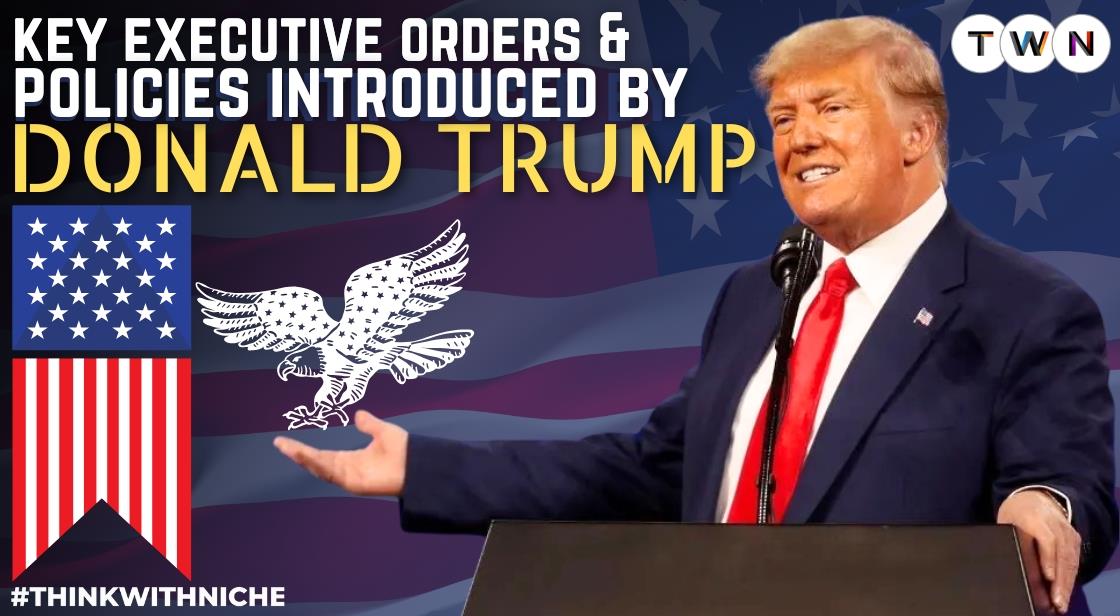Key Executive Orders and Policies Introduced by Donald Trump

Blog Post
Donald Trump, a polarizing yet influential figure in modern American politics, made headlines with his bold and often controversial decisions as the 47th President of the United States.
From his early days as a real estate mogul to his rise as a reality TV personality and, eventually, a political leader, Trump’s journey has been nothing short of extraordinary. His first day back in office was marked by decisive actions through executive orders, setting the tone for his renewed vision of "Making America Great Again."
This blog delves into the key executive orders and policies introduced by Donald Trump on his first day, reflecting his commitment to reshaping America’s domestic and international stance.
From immigration reform to global health policies, climate agreements, and redefining federal regulations, Trump’s agenda emphasized bold changes and a return to traditional values.
Beyond his presidential actions, this piece also explores Trump’s early life, career milestones, rise to prominence in the business world, and his transition to politics.
By examining Donald Trump's policies, controversies, and aspirations, this blog provides a comprehensive view of the man who continues to influence the political and cultural landscape of the United States.
Stay with us as we unpack Donald Trump’s defining moments, his ambitious vision for America’s future, and the legacy of his leadership.
Key Actions Taken by Donald Trump on His First Day as President
Early Life and Education of Donald John Trump
Donald John Trump was born on June 14, 1946, in Queens, New York City, to Fred Trump, a prominent real estate developer, and Mary Trump, a homemaker. Raised in a family with a strong business background, Trump was exposed to the real estate industry from an early age.
He attended Kew-Forest School in Queens and was known for his energetic personality, which often led to disciplinary issues. As a result, he was sent to the New York Military Academy at the age of 13 to improve his behavior and discipline.
Trump later attended Fordham University in the Bronx for two years before transferring to the Wharton School at the University of Pennsylvania in 1966. He graduated in 1968 with a degree in economics, an education that would serve as the foundation for his future career in business.
During his time at Wharton, Trump was known for his confident, ambitious nature and for building a network of contacts that would later help him in his business ventures.
Donald Trump Early Career and Entry into Business
After graduating in 1968, Trump joined his father’s real estate company, The Trump Organization, at the age of 22. Initially, he worked in the company’s real estate developments in Brooklyn and Queens but soon set his sights on Manhattan. In 1974, Trump took control of the Trump Organization and started making bold moves to expand the company’s influence in the heart of New York City.
One of his first major projects was the development of the Trump Tower in Manhattan, a 68-story skyscraper that was completed in 1983. The tower became a symbol of his ambition and vision, setting the stage for more high-profile projects in the years to come.
Under his leadership, the Trump Organization expanded its portfolio to include luxury hotels, casinos, and golf courses across the United States and abroad.
Donald Trump Rise to Prominence in the Business World
Throughout the 1980s and 1990s, Donald Trump became known for his high-profile real estate developments and his larger-than-life persona. He expanded his brand, attaching his name to buildings, hotels, casinos, and other luxury properties. His ventures were characterized by extravagant marketing and the Trump name becoming synonymous with wealth and success.
In the 1990s, however, Trump faced significant financial challenges. The real estate market was hit hard by an economic downturn, and some of his properties, particularly his casinos in Atlantic City, struggled.
He was forced to declare bankruptcy on several occasions to reorganize his debts and restructure his business. Despite these setbacks, Trump managed to regain his financial footing and continued to expand his business empire throughout the following decades.
Donald Trump as a Television Personality
In 2004, Trump ventured into the entertainment world by becoming the host of the reality TV show The Apprentice. The show was a massive success and ran for 14 seasons, turning Trump into a household name. His tough but charismatic persona and his iconic catchphrase “You’re fired!” became synonymous with the show, and it solidified his public image as a successful businessman and self-made billionaire.
The popularity of The Apprentice helped Trump build a brand that extended far beyond real estate, with his name appearing on a variety of products and ventures, from Trump Steaks to Trump University. The success of the show also contributed to his image as a larger-than-life figure, which would eventually propel him into politics.
Donald Trump Political Career and Presidency
In June 2015, Trump announced his candidacy for the presidency of the United States as a Republican, a move that surprised many. His unorthodox campaign style, which included inflammatory rhetoric and promises to “Make America Great Again,” attracted significant media attention. Despite initial skepticism, Trump’s populist message resonated with a large portion of the electorate, and he won the 2016 presidential election against Democratic nominee Hillary Clinton.
Trump’s presidency, which began on January 20, 2017, was marked by bold policy initiatives and divisive rhetoric. He focused on issues such as immigration reform, job creation, and economic growth. One of his most significant promises was to build a wall along the U.S.-Mexico border to curb illegal immigration. Trump’s administration passed significant tax reforms with the Tax Cuts and Jobs Act and pursued a deregulation agenda aimed at fostering economic growth.
Trump also made sweeping changes to U.S. foreign policy, including withdrawing the United States from the Paris Climate Agreement and renegotiating NAFTA, which resulted in the new USMCA agreement. His foreign policy approach was characterized by an "America First" stance, focusing on reducing international trade deficits and asserting U.S. power on the global stage.
Also Read: Understanding the U.S. Presidential Election Process: A Complete Guide for 2024
Donald Trump First Term as President (2017–2021)
Trump’s first term in office was marked by a series of controversial decisions, including the implementation of travel bans targeting several Muslim-majority countries and a strict stance on immigration.
He also faced significant challenges with the onset of the COVID-19 pandemic in 2020, which became a defining issue of his presidency. While his administration initially downplayed the severity of the virus, the pandemic eventually led to widespread criticism of his handling of the crisis.
In December 2019, Trump was impeached by the House of Representatives on charges of abuse of power and obstruction of Congress over his dealings with Ukraine. However, he was acquitted by the Senate in early 2020. Trump’s presidency also saw widespread protests against racial inequality and police violence, which led to contentious debates about law enforcement and civil rights.
In the 2020 presidential election, Trump lost to Democratic nominee Joe Biden. Following the election, Trump and many of his supporters falsely claimed widespread voter fraud, leading to the January 6, 2021, attack on the U.S. Capitol by pro-Trump extremists. The event marked a significant chapter in Trump’s presidency and was followed by his second impeachment by the House of Representatives.
Donald Trump Post-Presidency
After leaving office in January 2021, Trump remained a central figure in American politics. He maintained a strong influence within the Republican Party, frequently endorsing candidates who aligned with his political views and continuing to promote his "America First" agenda.
Trump also faced ongoing legal challenges, including investigations into his business practices and his role in the January 6 Capitol riot. Despite these challenges, Trump has hinted at a potential return to the presidency in future elections, with many of his supporters still rallying behind him.
Personal Life Of Donald Trump
Donald Trump has been married three times. His first marriage was to Ivana Trump, with whom he had three children: Donald Jr., Ivanka, and Eric. The couple divorced in 1992, and Trump married actress Marla Maples in 1993, with whom he had one daughter, Tiffany. He married his third wife, Melania Trump, in 2005, and the couple has one son, Barron.
Trump is known for his larger-than-life personality and his lavish lifestyle, which includes luxury properties, private jets, and golf courses. He is a polarizing figure, with supporters praising his outsider status and his focus on American interests, while critics accuse him of promoting divisive rhetoric and undermining democratic institutions. Throughout his career, Trump has maintained an image of self-confidence and resilience, often embracing the persona of a self-made billionaire and an unconventional leader.
Donald Trump Sworn in as the 47th President of the United States
On Monday, January 20th, Donald Trump was officially sworn in as the 47th President of the United States, marking the ceremonial transition of power at the Capitol Rotunda. The event, which took place amid freezing temperatures, was attended by former presidents, prominent tech billionaires, and lawmakers, marking a dramatic shift in American history with the conclusion of one administration and the beginning of another.
Donald Trump Inaugural Speech: A Bold Vision for America’s Future
Trump’s inaugural speech set the tone for his presidency, outlining his bold vision for America, which he claims is on the brink of a “golden age.” At the start of his address, he declared, "The golden age of America begins right now," positioning himself as the leader who would restore the nation to greatness.
He promised to prioritize American interests and stressed that the era of America’s decline was over. However, Trump quickly transitioned to more confrontational rhetoric, targeting his political rivals, particularly the Biden administration, which he accused of mismanaging domestic and international crises.
Donald Trump Unity and Strength: Themes of the Inaugural Address
A central theme in Trump’s speech was unity. He referred to the day as “liberation day,” claiming his victory represented a rapidly unifying nation behind his agenda. Trump expressed his desire to be remembered as a peacemaker and unifier, closing his address with a strong message of resilience: "We will not be intimidated. We will not be broken, and we will not fail."
Donald Trump's Key Executive Orders on First Day in Office
Donald Trump Deportations and birthright citizenship:
Donald Trump signed an executive order to end automatic birthright citizenship for children of non-permanent residents. This move has sparked significant legal challenges, as birthright citizenship is enshrined in the 14th Amendment of the US Constitution.
The order has already faced lawsuits from 22 states, arguing that the president cannot unilaterally change constitutional rights. The outcome of this legal battle remains uncertain, but it has certainly stirred up a lot of debate.
Donald Trump withdrawal from WHO 2025
Donald Trump signed an executive order to withdraw the US from the World Health Organization (WHO) on his first day back in office. The reasons cited for this decision include WHO’s handling of the COVID-19 pandemic, failure to adopt reforms, and perceived political influence from member states. This move has raised concerns among health experts about the potential impact on global health initiatives and pandemic preparedness.
Donald Trump’s Recognition of Two Genders
Doanald Trump made it official policy that there are only two recognized sexes, male and female, reinforcing the definitions in all federal regulations and documents.
Donald Trump signed an executive order declaring that the US government will recognize only two sexes, male and female. This policy affects federal regulations and documents, including passports and visas. The order also ends federal funding for gender identity recognition and diversity programs. This move has sparked significant controversy and is expected to face legal challenges.
Donald Trump’s Paris Agreement withdrawal 2025:
Donald Trump ordered the US to start the process of withdrawing from the Paris Climate Agreement. He also invoked emergency powers to expand US energy production by reversing climate-related policies and facilitating oil, gas, and mining activities. This move has sparked significant debate, with supporters arguing it will boost the economy and critics warning it could have severe environmental consequences.
Donald Trump Asylum and Refugees
Donald Trump suspended refugee resettlement for six months and signed executive orders to end “catch and release” policies. Plans were also announced to reinstate the "Remain in Mexico" policy for asylum seekers.
Donald Trump Death Penalty for Illegal Immigrants
The Department of Justice was directed to pursue the death penalty for illegal immigrants who harm American citizens, marking a significant policy shift.
Donald TrumpSweeping Death Penalty Order
Trump signed a comprehensive execution order, instructing the attorney general to ensure states have adequate supplies of lethal injection drugs to carry out executions.
Donald Trump Reinstating Vaccine Objectors
A pledge was made to reinstate military personnel expelled for refusing the Covid-19 vaccine. Those affected will be provided with full back pay as part of this initiative.
Donald Trump Return to In-Person Work
Trump mandated the return of federal employees to office-based work, effectively ending work-from-home policies across federal agencies.
Donald Trump Federal Hiring Freeze
A hiring freeze for federal employees was implemented, with exceptions for critical areas such as immigration enforcement and national security.
Donald Trump Creation of an External Revenue Service
Trump announced the establishment of an "External Revenue Service" to focus on collecting tariffs, with promises of boosting revenue for the U.S. Treasury.
Donald Trump Inflation Emergency Measures
Agencies were directed to address inflation by targeting housing and healthcare costs while rolling back climate policies that drive energy price increases.
Donald Trump Expansion of Offshore Drilling
Trump ordered increased offshore drilling and committed to refilling the U.S. Strategic Petroleum Reserve to its full capacity, aiming to strengthen energy independence.
Donald Trump Executive Actions: Border Security and Free Speech
Following his inauguration, Trump outlined several immediate executive actions. He announced plans to declare a national emergency at the US-Mexico border, emphasizing his firm stance on border security. Additionally, he pledged to sign an executive order aimed at curbing government censorship and restoring free speech in America. These actions are expected to be controversial, particularly regarding his stance on immigration and national security.
Donald Trump Immigration and National Security: A Sharp Critique of Biden’s Administration
Trump sharply criticized the Biden administration’s handling of border security, accusing it of allowing “dangerous criminals” to cross into the country illegally. He stated that the previous administration had failed to protect American citizens from these threats and vowed to take immediate steps to secure the borders.
Donald Trump Addressing National Challenges: Natural Disasters, Energy, and Trade
Trump also addressed other critical issues facing the nation. He expressed alarm over the federal government’s inadequate response to recent natural disasters, such as the deadly wildfires in Los Angeles and Hurricane Helene in the southeastern U.S. He called for a stronger federal presence during emergencies.
Energy policy was another focal point, with Trump reiterating his commitment to an energy strategy that prioritizes domestic drilling to combat inflation. His stance on clean energy and international trade was also notable, as he pledged to overhaul the nation’s trade system, imposing taxes and tariffs on foreign goods to support American industries.
Donald Trump Critique of Public Health and Education Systems
Trump took aim at the U.S. public health and education systems, accusing both of failing to properly serve citizens. He claimed that schools were indoctrinating children to hate their country, a recurring theme in his critique of what he views as the “radical left” influencing American culture.
Attack on President Biden: A Nation in Disarray
In perhaps the most pointed part of his speech, Trump criticized President Joe Biden, accusing him of mishandling both domestic and international crises. Trump painted a picture of a country in turmoil under Biden’s leadership, contrasting it with his vision of strength, order, and prosperity.
The Transition to the White House: A Symbolic Change
As the new administration settled in, preparations for the Trump family’s return to the White House were in full swing. Moving trucks were seen outside the residence as staff worked to remove the Biden family’s belongings and make room for the Trump family’s arrival. By that afternoon, everything was ready for the transition, from unpacked personal items to clothes in the closets.
Symbolic Changes in the Oval Office
The transition was also marked by changes in the White House décor. A rug designed by former First Lady Nancy Reagan, which Trump had used during his first term, was brought back to the Oval Office, along with a portrait of Andrew Jackson, a historical figure admired by Trump.
Fashion Statement: Melania Trump’s Inaugural Outfit
Melania Trump’s outfit for the day made a strong impression. Designed by New York-based milliner Eric Javits, her structured hat nearly obscured her eyes, complementing a military-style ensemble that exuded both elegance and authority, making it a standout moment in the inauguration’s fashion.
Conclusion: The Path Ahead for Trump’s Presidency
With his inaugural speech, Donald Trump has outlined his plans for the next four years of his presidency, focusing on key issues such as immigration, national security, and economic reform. While his address promised unity and strength, it remains to be seen how his administration will address the many challenges ahead.
You May Like
EDITOR’S CHOICE












